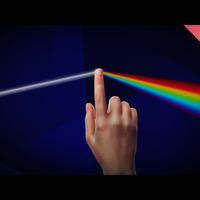Can You Bend Light With Your Finger?
Thanks to curiosity stream for supporting PBS Digital Studios
Hey guys, Joe here. What do people used to do when they were born before we had all these devices to keep us occupied
Back to the old days people had to be more creative
Next time you feel like life's going too slow
Why not put those idle hands to use and play with the fastest thing in the universe
Here's three experiments that will show you how to bend light itself using nothing, but your own two hands
Try this close one eye look at something across the room
Preferably with a nice straight edge or an interesting pattern next put your finger a few inches in front of your eye
or a few centimeters
It's your choice now
Focus on that object and let your eye relaxed until both your finger and the background are slightly out of focus
when you move your finger side-to-side
look what happens the
Light seems to bend around your finger for some people it may bend toward your finger for some it may bend away
With a few tries you should be able to do this pretty easily
What's going on here is your finger tugging and the fabric of the universe
Well a little bit everything with mass warp space-time by some amount but your finger isn't nearly massive enough for it to be noticeable
Unless you have a black hole in your finger, which would really suck
Get it
We'll explain that but first let's try another one for the next experiment close one eye and look at something bright in the distance
Not the Sun
Never look at the Sun ever just don't do it
With one eye shut slowly bring your two fingers together just in front of your eye just before they touch
They seem to reach out and melt into one another
Try it with two objects out on a sunny day right before two shadows touch they seem to push out and join
That is cool. You're basically a wizard now bending light and bending dark
Finally for the third experiment blow is one eye again and slowly bring two fingers together near your eye
While watching the light through a slit in between them you should see a series of dark lines
Form as you move your hand back and forth the pattern of those dark lines can change
What's going on here?
How do these light bending experiments work well let science them and figure it out?
I'm gonna repeat the bending light with the camera is your eye
I'm pointing it at a grid on my computer screen a key to why this works is that we keep the background
slightly out of focus
So what's going on here? It has to do with what happens when light passes through a lens in your eye
Or in a camera take any point out here in front of the lens
Light reflects off that point spreads out passes through the lens and it's bent toward a different point behind the lens
The spot where the light comes together is called the focal point the lens in your eye
And the camera works in different ways to focus images your eye physically changes the shape of the lens while a camera
Moves it both alter the point where light from different distances comes together
When the lens is out of focus light rays from a fixed point don't come together
Exactly on the sensor or our retina the resulting blurred image is formed by separate light rays passing through different parts of the lens
If we insert something in between the object and the lens like a finger and block some of those rays
We've actually made part of the image disappear the center of the blurry area shifts to one side now a lens
inverts the image and our brain or
camera flips whatever falls on the sensor
So if we focus in front of the background the object appears to move away from our finger if we focus behind the background
It seems to bend toward our finger
This even works when we look at a thin object edge on at its most extreme
We can bend the grid so much that it breaks in
Reality light at any point spreads out at a three-dimensional cone, but this all works in the same way
Putting something between our eye and an object narrows that cone of light
We're not really bending light after all for blocking it block enough light and you create a shadow
Like in our second experiment when the shadows of your two fingers or other objects
Mysteriously bulged toward each other when they got close
This is called the shadow blister effect and to understand how it works you need to understand the parts of a shadow
The darkest part of a shadow where an object completely blocks the source of light is called the Umbra
This is the familiar dark part. We typically call the shadow, but around the edges
We're only part of the light is blocked by an object
We have the hazy ur penumbra for your typical shadow cast by a bright light source like the Sun
We don't see this hazy penumbra around the edge our eyes can't make out the tiny difference in contrast
But when two of these penumbra overlap when two shadows get close enough together
They can block enough light to become visible or invisible
And the shadows appear to bulge out, so what about those dark bands. We saw between our fingers
most of the explanations out there including several in textbooks say, this is a demonstration of diffraction the
Interference of light waves after they pass through something like a narrow slit, that would be really cool
But I'm not sure that's what's happening here and the experts I've asked about it agree for a few reasons
first for diffraction to work we usually need a
Coherent light source like a point of light or a laser that sends light waves out only in one direction. We don't have that here
Second since different wavelengths or colors of light diffract
Differently white light should give us some strange colored bands, not just dark ones
Finally to see diffraction through a single slit
it usually needs to be much narrower relative to visible light than the gap you can make with your fingers I
Think there's something else going on here
but I'm not sure what maybe something due to the shape and size of the eye or the
Iris or even an illusion caused by how our brains detect edges or different levels of light or?
Maybe it's diffraction after all even though
I'm almost certain that it's not I think I want you to try this and do some experiments of your own
let me know what you think is going on and why I especially want to hear from you if you're an optical physicist or a
neuroscientist or something like that
But everyone is welcome to do some science on this we can solve it you can learn a lot from a little boredom
many great scientists including
Einstein made time to be bored to let their minds wander one of Einstein's famous thought experiments
Led to his theory of general relativity
This predicted a different kind of light bending called gravitational lensing where massive
Objects warp space-time enough to actually bend light from a distant source
This idea may be inspired by boredom was observed in a 1919 solar eclipse and in later
observations like Einsteins cross
Bending of light from gravitational lensing has even offered experimental support for the existence of matter
We can't see dark matter often when we're bored our reflex is to find something to do with these things
But next time you find yourself
Unconsciously picking up one of these things remember that a couple idle hands can inspire awesome things
Stay curious
Ha so being bored can be a good way to inspire curiosity
Speaking of curiosity, thank you to curiosity stream for supporting PBS Digital Studios
Curiosity stream is a subscription streaming service that offers
documentaries and nonfiction titles from some of the world's best filmmakers including exclusive originals
I've been watching dream the future a 19 part series that asks leading visionaries to predict
What life will be like in 2050 it's exclusive of curiosity stream?
And it's narrated by Sigourney Weaver the first 10 episodes are streaming right now
You can get unlimited access today and for our audience the first 60 days are free if you sign up at curiosity stream
Comm slash smart and use the promo code smart during the signup process
You

